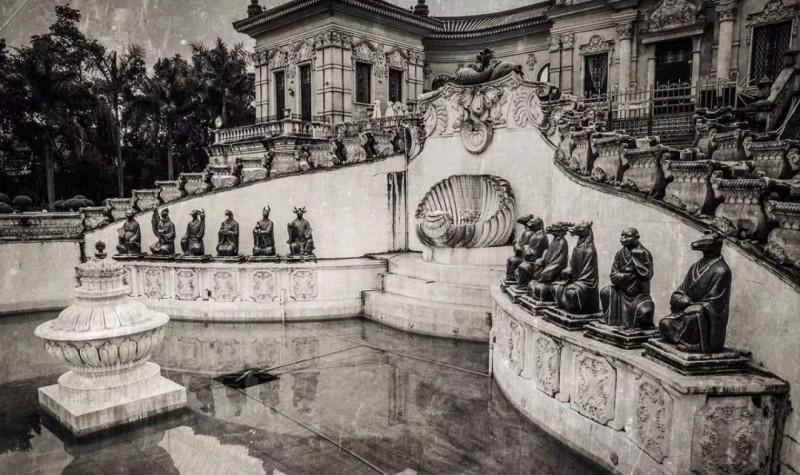Over the past decades, news reports on the return of the heads of the 12 zodiac animal bronze statues from the Old Summer Palace or Yuanming Yuan have aroused the concern of the Chinese masses. These bronze statues were beautifully designed. They are lifelike stunning works of art. The statues have drawn widespread attention because they carry with them the memory of humiliation in modern China. Their return has always been a matter of concern to many Chinese. So who designed the bronze statues? What is the story behind their creation?
In 1715, Giuseppe Castiglione, a young Italian Jesuit, came to China. His primary mission in China was, of course, to preach the gospel, but at that time the Manchu authorities had a policy of not permitting Christianity to be preached in the country. The missionaries could not do much about this edict so they each had to find other ways to stay in China. Fortunately, all the Qing emperors fancied works of art and Castiglione was highly skilled in painting, enabling him to enter the royal court and work as a royal artist.
Castiglione explored a new method of painting by integrating Western and Chinese styles in his works. He created a groundbreaking new painting method that became known as the “Castiglione Novelty.” In China Castiglione painted for more than 50 years, serving three different administrations of kings. He was one of the designers of the Western-themed garden. His contribution influenced the painting and aesthetic taste of the Qing royal court. His representative works were "Ten Dogs," "100 Horses," "Emperor Qianlong’s Grand Portrait," "Harvest Valley," "Flowers and Birds," and "100 Children."
In order to expand the size of the Old Summer Palace, Emperor Qianlong specifically wanted to design a Western-style garden, which he named The Hall of National Peace. The Emperor assigned the French missionary P. Benoist Michel and Giuseppe Castiglione to be responsible for its design. According to historical records, in the Hall "there is a high platform made of stone bricks, which has an in-built water tank. The tank supplies water for the surrounding fountains. The reservoir was covered tight with tin plates to prevent leakage. So it was called 'tin sea.' The tank can hold 180 tons of water. Water is stored by using the 'dragon tail cart' (a machine that operates by a mechanical principle that raises the water level) to send water upwards to the 'tin sea,' and then relying on gravity, water is made to run through the bronze pipes that lead to the fountains."
The central piece of the complex was its large fountain pool. On each side of the pool stood the 12 Chinese zodiac bronze statues, formed with human bodies and animal heads. The statues sprayed water to announce the time and thus they got the name “hydraulic clock.” It was Castiglione who designed the 12 bronze statues. It was said that he originally planned to adopt female sculptures which were popular in the West as the water-spraying devices. However, the proposal was opposed by many as the idea was thought to be inconsistent with traditional Chinese etiquette. So Castiglione took into account the different viewpoints and decided to use the Chinese zodiacs as the design. The idea did not only conform to the aesthetic appreciation of the Chinese people, but also the concept of the Chinese zodiacs in ancient times was said to be related to time. What a great idea this was!
Castiglione truly made a unique and vivid design by combining human bodies and animal heads. According to historical records: "The 12 statues are distributed evenly along the south-north bank of the fan-shaped fountain pool. On the south bank are the rat (11 pm – 1 am), tiger (3 am – 5 am), dragon (7 am – 9 am), horse (11 am – 1 pm), monkey (3 pm – 5 pm), and dog (7 pm – 9 pm). On the north bank are the ox (1 am – 3 am), rabbit (5 am – 7 am), snake (9 am – 11 am), sheep (1 pm – 3 pm), rooster (5 pm – 7 pm), and swine (9 pm – 11 pm)." The 12 zodiac forms each take their turn to spray water around the clock. At noon, the mouths of the 12 bronze statues spray water at the same time, forming a spectacular scene. The fountain reflected the perfect combination of Western architectural art and traditional Chinese culture. It truly deserved the title of a national treasure.
In 1860, the Old Summer Palace was looted, destroyed and burned by British troops (many of them were Indian mercenaries). Many precious works of art and relics including the zodiac animal heads of the bronze statues were stolen and scattered around the world. However, in the 21st century, some of the bronze animal heads have been returned to the motherland. As of November 2019, seven heads – the ox, monkey, tiger, swine, rat, rabbit and horse – have been returned home. It is believed the other five animal heads will be returned in the near future.
- Translated by Charlie Li












